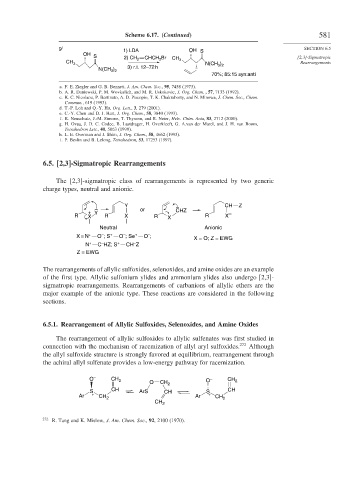Page 607 - Advanced Organic Chemistry Part B - Reactions & Synthesis
P. 607
Scheme 6.17. (Continued) 581
9 i 1) LDA OH S SECTION 6.5
OH S
2) CH 2 CHCH 2 Br CH 3 [2,3]-Sigmatropic
CH 3 Rearrangements
N(CH 3 ) 2
3) r.t. 12–72 h
N(CH 3 ) 2
70%; 85:15 syn:anti
a. F. E. Ziegler and G. B. Bennett, J. Am. Chem. Soc., 95, 7458 (1973).
b. A. R. Daniewski, P. M. Wovkulich, and M. R. Uskokovic, J. Org. Chem. ,57, 7133 (1992).
c. K. C. Nicolaou, P. Bertinato, A. D. Piscopio, T. K. Chakraborty, and N. Minowa, J. Chem. Soc., Chem.
Commun., 619 (1993).
d. T.-P. Loh and Q.-Y. Hu, Org. Lett., 3, 279 (2001).
e. C.-Y. Chen and D. J. Hart, J. Org. Chem., 58, 3840 (1993).
f. K. Neuschutz, J.-M. Simone, T. Thyrann, and R. Neier, Helv. Chim. Acta, 83, 2712 (2000).
g. H. Ovaa, J. D. C. Codee, B. Lastdrager, H. Overkleeft, G. A.van der Marel, and J. H. van Boom,
Tetrahedron Lett., 40, 5063 (1999).
h. L. E. Overman and J. Shim, J. Org. Chem., 58, 4662 (1993).
i. P. Beslin and B. Lelong, Tetrahedron, 53, 17253 (1997).
6.5. [2,3]-Sigmatropic Rearrangements
The [2,3]-sigmatropic class of rearrangements is represented by two generic
charge types, neutral and anionic.
Y CH Z
– or CHZ
+ Y –
R X R X R X R X
Neutral Anionic
–
–
–
X = N + O ; S + O ; Se + O ; X = O; Z = EWG
–
–
N + C HZ; S + CH Z
Z = EWG
The rearrangements of allylic sulfoxides, selenoxides, and amine oxides are an example
of the first type. Allylic sulfonium ylides and ammonium ylides also undergo [2,3]-
sigmatropic rearrangements. Rearrangements of carbanions of allylic ethers are the
major example of the anionic type. These reactions are considered in the following
sections.
6.5.1. Rearrangement of Allylic Sulfoxides, Selenoxides, and Amine Oxides
The rearrangement of allylic sulfoxides to allylic sulfenates was first studied in
connection with the mechanism of racemization of allyl aryl sulfoxides. 272 Although
the allyl sulfoxide structure is strongly favored at equilibrium, rearrangement through
the achiral allyl sulfenate provides a low-energy pathway for racemization.
O – CH 2 O CH 2 O – CH 2
S CH ArS CH S CH
Ar + CH 2 Ar + CH 2
CH 2
272
R. Tang and K. Mislow, J. Am. Chem. Soc., 92, 2100 (1970).

